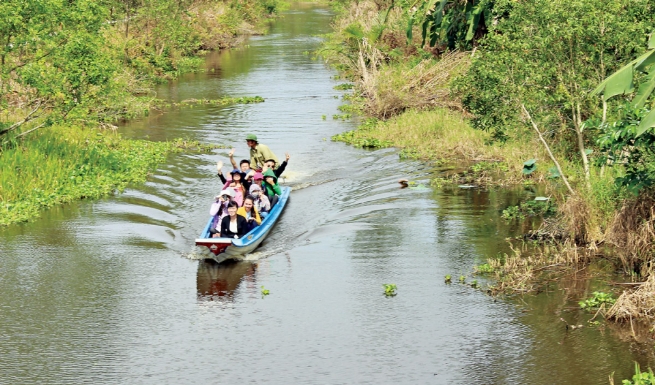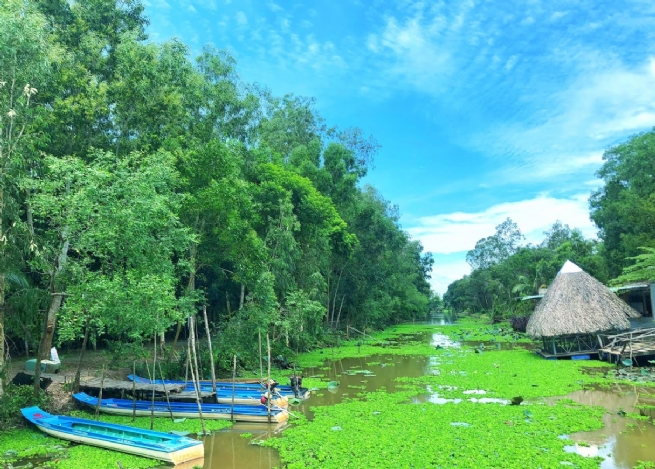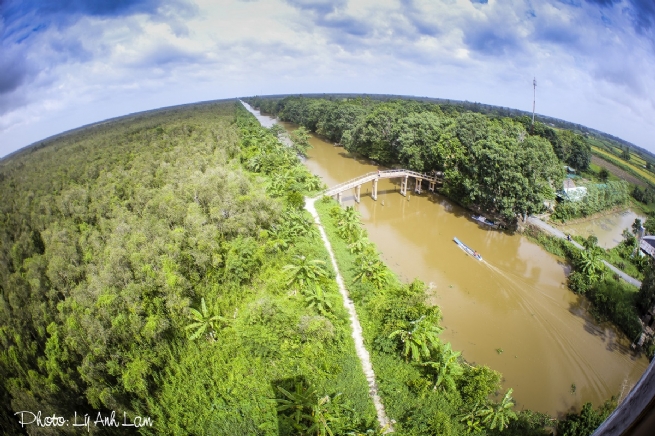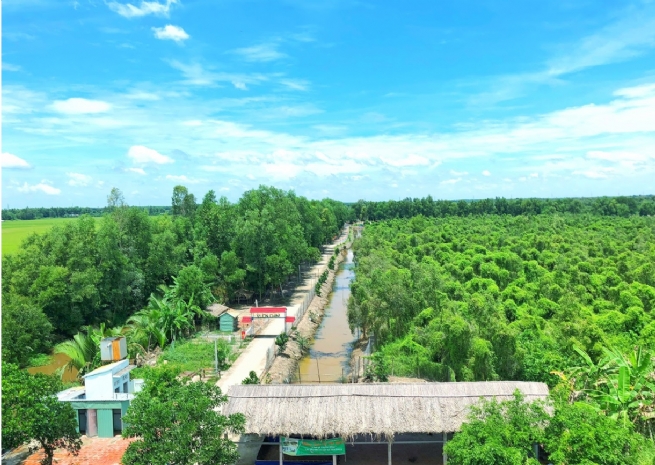Not only known as the "green lung" of the Mekong Delta, Lung Ngoc Hoang Nature Reserve is also a unique biodiversity conservation area home to a variety of indigenous flora and fauna of the southwestern river region. “Always clearly understanding this valuable value, the Management Board of Lung Ngoc Hoang Nature Reserve has made great efforts to advise and execute solutions to conserve, protect, and rationally use values of natural resources, habitats, flora and fauna and typical culture in the region,” said Mr. Lu Xuan Hoi, Director of the Management Board of Lung Ngoc Hoang Nature Reserve.
Could you please briefly introduce the picture of Lung Ngoc Hoang Nature Reserve? What are its outstanding features and meanings for the development of the Mekong Delta?
Located in Phung Hiep district, 40 km from Can Tho City, Lung Ngoc Hoang Nature Reserve is a wetland area of 2,805.37 ha, stretching from the west of the Hau River to the U Minh region.

According to the “Can Tho geography” book (2003), this place was reclaimed over 120 years ago. Before 1945, some landlords hired people to farm and catch fish there. Lung Ngoc Hoang also became a revolutionary base during the two resistance wars against the French and the Americans. In the past, this area was assigned to Phuong Ninh Forest Enterprise to grow melaleuca trees, catch aquatic resources and protect the environment. In 2002, Lung Ngoc Hoang Nature Reserve was established to become a prominent destination for Hau Giang tourism.
Lung Ngoc Hoang Nature Reserve currently has 976 species of flora and fauna, including 352 species of higher plants, 57 species of fungi, 59 species of benthic animals, 62 species of spiders, 100 species of insects, 13 species of mollusks, 173 species of algae, 75 species of fish, 72 species of birds, eight species of amphibians, 31 species of reptiles and 14 species of mammals. Particularly, many species of rare flora and fauna are recorded in the Red Book of Vietnam and the World Red Book such as Ca Na (Elaeocarpus hygrophilus Kurz) and Lua Ma (Oryza rufipogon Griff).
Currently, Lung Ngoc Hoang Nature Reserve is divided into three main subdivisions: Strictly protected zone of 1,015.32 ha, ecological rehabilitation zone of 937.11 ha and administrative service zone of 853.32 ha. The reserve is also surrounded by 8,836.07 ha of buffer zone. The ecosystem is being strictly protected and developed in the direction of respecting natural succession of the ecosystem and preserving inherent features of the southwestern wetland.
In the past time, what solutions and activities has the Management Board of Lung Ngoc Hoang Nature Reserve advised and implemented to protect, exploit and promote the values of natural resources, habitats, flora, fauna and typical culture of the nature reserve?
Over the past years, Lung Ngoc Hoang Nature Reserve has been protected by the entire political system, including the coordination of the Department of Agriculture and Rural Development, the Forest Protection Department, the Fire Police Department, and police force of Hau Giang province, Phung Hiep district and commune authorities.
In addition to establishing and maintaining a specialized apparatus subordinated to the Hau Giang Provincial People’s Committee, Hau Giang province has invested resources for research, conservation and development of some works, like dredging the canal network, building watchtowers for fire prevention and forest protection, and purchasing large-capacity machinery and equipment to deal with a potential forest fire.

The Management Board of Lung Ngoc Hoang Nature Reserve has continuously fostered employee education, upheld the sense of responsibility and successfully completed its tasks, especially the regular 24/24 patrol and observation to ensure timely detection of incidents. The Board has also coordinated with mass organizations to regularly educate forest fire prevention and forest protection in the dry season. In particular, it built 14 self-management units and five forest fire prevention units. The Management Board also developed a collective agreement on forest protection and forest fire prevention between Lung Ngoc Hoang Nature Reserve with contiguous communes and Phung Hiep Forest Protection Department. So, no forest fires occurred since 2011.

In addition, the Management Board regularly checks salinity level, surveys water levels in forest plots, investigates and assesses the current status of biodiversity, changes in some plant and animal species and proposes the addition of new species to the Vietnam Red Book. While effectively managing the showroom (90 plant samples and 81 animal samples), it has also worked with agencies and organizations such as the Biodiversity Conservation Agency, the World Wide Fund for Nature (WWF), the Mekong River Commission, the Southern Institute of Ecology, and media agencies to recognize the existing fauna and flora and introduce and introduce Lung Ngoc Hoang Nature Reserve to call for ecotourism investment.
In the Hau Giang tourism development direction, linking agritourism with diverse types of accommodation is a potential approach and Lung Ngoc Hoang Nature Reserve is considered the central highlight to “activate” surrounding tourism development. What solutions will the Management Board advise and implement to awaken a “sleeping beauty” and create a driving force for tourism development?
Lung Ngoc Hoang Nature Reserve has rich potential to be built into a tourist destination, with environmentally friendly forest-edge residences with various accommodation and dining services such as homestay, ecolodge, farmhouse, hotel and spa. Besides, it possibly develops different types of tourism such as discovering melaleuca forest, native trees replanted by humans, exploring the hills, the ancient river, visiting bird sanctuaries, observing wild native plants and animals, wild bee hives, nearly 40 years old melaleuca forests and typical village landscapes of indigenous residents.

To promote tourism at Lung Ngoc Hoang Nature Reserve, Hau Giang province is currently developing transport infrastructure to connect tourist sites. Regarding road traffic, priority will be given to building a road connecting Provincial Road 927 to the nature reserve and arranging waterway traffic from Gia Bay City to the Administrative Area of Lung Ngoc Hoang Nature Reserve in order to combine key traffic routes with tourism sites.
The Management Board also proposed the province and relevant bodies to soon invest in essential infrastructure such as an operating center for ecotourism, large meeting rooms, serviced residences and bungalows equipped with comforts and amenities for tourists. The board also sent the staff to training courses on tourist services because, in addition to the knowledge of nature conservation and understanding of characteristics and values of animal and plant resources, landscapes, culture, history of the forest, the staff, assigned to be in charge of tour guide and tourist services, need to have skills in communications, behaviors, foreign languages, information technology and rescue among others. Believing that, directed and supported by relevant authorities of all levels and the cooperation of local people, tourism activities at Lung Ngoc Hoang Nature Reserve will develop strongly in the near future.
Source: Vietnam Business Forum